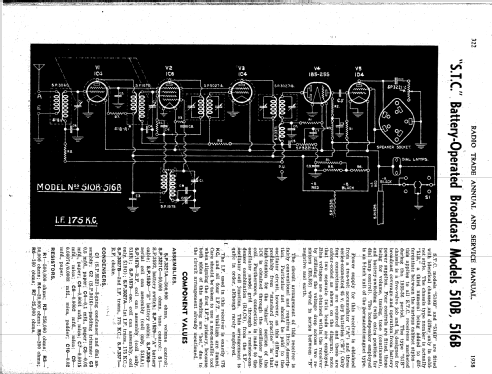- Pays
- Australie
- Fabricant / Marque
- Standard Telephones and Cables Pty, Ltd (STC), Sydney
- Année
- 1936
- Catégorie
- Radio - ou tuner d'après la guerre 1939-45
- Radiomuseum.org ID
- 169747
Cliquez sur la vignette du schéma pour le demander en tant que document gratuit.
- No. de tubes
- 5
- Principe général
- Super hétérodyne avec étage HF; FI/IF 175 kHz; 2 Etage(s) BF
- Circuits accordés
- 7 Circuits MA (AM)
- Gammes d'ondes
- PO uniquement
- Tension / type courant
- Piles (rechargeables ou/et sèches) / 135 & 2 Volt
- Haut-parleur
- HP dynamique à aimant permanent + bobine mobile / Ø 8 inch = 20.3 cm
- Matière
- Boitier en bois
- De Radiomuseum.org
- Modèle: 510B Ch= 51B - Standard Telephones and Cables
- Forme
- Console avec pieds bas < 50% de la hauteur
- Remarques
-
S.T.C. models "510B" and "516B" are fitted with identical chasses and differ only in cabinet style. The chassis type number is actually "51B," a third numeral being added to differentiate between the various cabinet styles this applies to all S.T.C. receivers marketed during the 1935-36 period. The type "51B” chassis is a five-valve job and is designed for broadcast coverage and operation from battery power supplies. Four controls are fitted, these being for volume, tuning, tone (continuous), and battery-switching (with an extra position for dial lamp control).
The loudspeaker employed is an 8-inch unit of the permanent magnet type.The power supply for this receiver is obtained from a two-volt accumulator ("A") and three series-connected 45 v. dry batteries ("B"). Only four connections are required and these are colour coded as shown on the diagram; note that two separate twin leads are employed.
Bias voltages are obtained within the receiver by utilising the voltage drop across two resistors (R5, R6) wired in series between "B" negative and earth.
The circuit arrangement of this receiver is fairly conventional and requires little description.
Particular notice should be paid to the oscillator circuit, however, as this differs appreciably from "standard practice" in that high tension for the "mixer" section of the 1C6 is obtained through the oscillator plate coil. Furthermore, the connection is made to the oscillator anode grid through a resistor-condenser combination (R4, C4), from the IF oscillator coil junction. This arrangement is quite in order, although rarely employed.
The IF used in this receiver is exactly 175 KC. and all four IFT windings are tuned.
Care should be taken to use a non-metallic tool when aligning the first IFT primary, because both sides of this winding are "hot," due to the circuit arrangement already mentioned.
Radio Trade Annual 1939, Page 322.
- Prix de mise sur le marché
- 29.00 Aus£
- Schémathèque (1)
- Radio Trade Annual 1938 P322.
- Auteur
- Modèle crée par Stuart Irwin. Voir les propositions de modification pour les contributeurs supplémentaires.
- D'autres Modèles
-
Vous pourrez trouver sous ce lien 616 modèles d'appareils, 272 avec des images et 305 avec des schémas.
Tous les appareils de Standard Telephones and Cables Pty, Ltd (STC), Sydney



